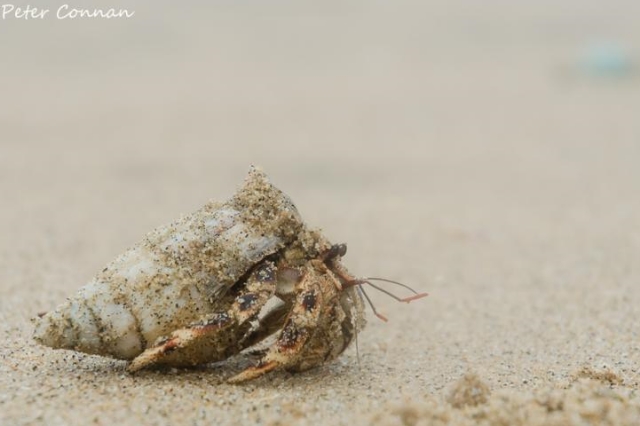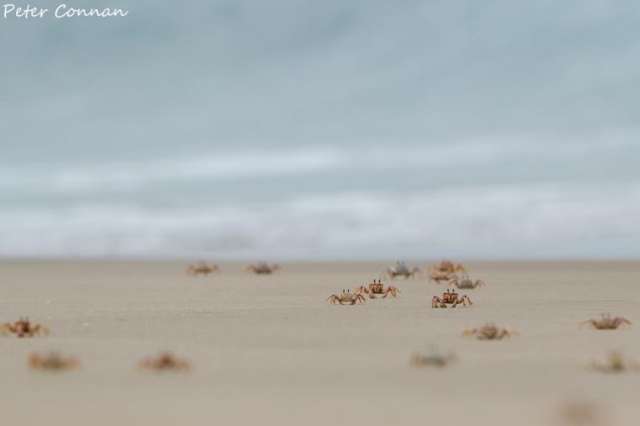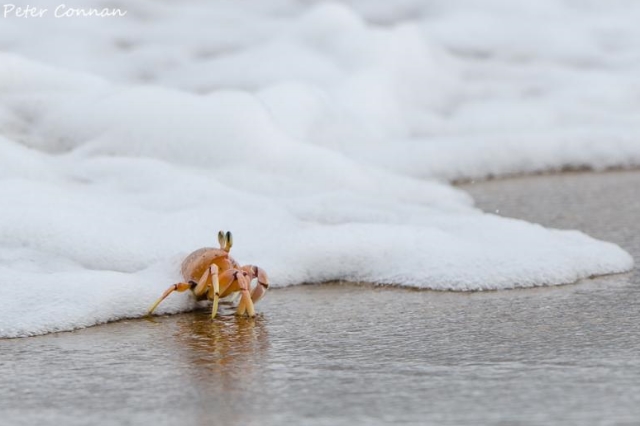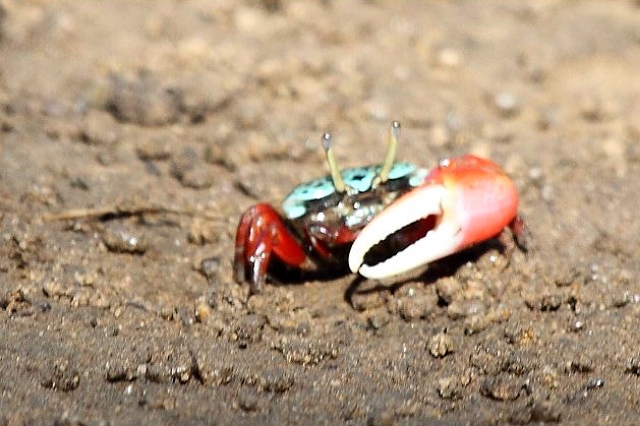Common Land Hermit Crab, Concave Land Hermit Crab Coenobita cavipes
Subphylum Crustacea. Order Decapoda. Family Coenobitidae

© Peter Connan
Maphelane, iSimangaliso Wetland Park, KwaZulu-Natal
Description
Size: Length of first part of cephalo-thorax 30-40 mm.
Eyes are elongated and the stalks are mostly black on adults. In juveniles, the lower portion of the stalk is black. Ocular peduncles generally white with broad dark band at midlength and dark brown patch and tinge of blue at base of cornea. Ocular peduncles half shield length or slightly less, corneas only faintly dilated; ocular acicles each with small submarginal spine. Antennular and antennal peduncles overreaching ocular peduncles.
Bottom section of second antenna are orange. Distal two segments of antennular peduncles each with broad band of reddish-brown and tinge of blue distally. Fifth segment of antennal peduncle transparent with brown mesial and lateral stripe. The anntenal aicicle is fused to the second segment of the peduncle.
No stitch marks on large claw. Chelipeds generally brown with capsulate tubercles gray to blue-gray and spines brown to yellowish-brown; meri brown with spots of blue-gray. Chelipeds grossly unequal, both provided with numerous tufts of short or moderately short setae, often concealing armature, palms and carpi also with numerous capsulate setae on dorsal and lateral surfaces; dorsomesial and dorsolateral margins of palm of right cheliped each with row of small spines, dorsal surface with scattered small, often capsulate spines, one more prominent in midline; carpus with row of prominent spines on dorsomesial margin, dorsal surface with scattered capsulate tubercles and small spines, dorsolateral margin not delimited.
Left cheliped with chela elevated in midline but not forming distinct ridge, but armed with row of moderately large spines extending onto proximal half of fixed finger, dorsolateral surface with numerous capsulate tubercles, dorsomesial surface with scattered small spines; dorsomesial margin of carpus with row of large spines, dorsolateral margin only weakly delimited by few small spines.
Third left leg is armored. Ambulatory legs similar; dactyls very slightly shorter to somewhat longer than propodi, ventral margins each with row of 7–10 prominent corneous spines; propodi unarmed but with transverse rows of long setae; carpi each with dorsodistal spine and tufts of long plumose setae. Telson with posterior lobes separated by small median cleft; terminal margins almost straight to very slightly concave, each with row of small spines, interspersed with minute spinules. Ambulatory legs with dactyls brown proximally, white distally; propodi reddish-brown proximally, blue-gray distally; carpi brown to reddish-brown, spotted with blue-gray; meri each brown proximally with large dorsal white patch and blue-gray distally with large dorsal brown patch.
Distribution
Found in the Indo-Pacific region: Eastern Africa, South Africa (east coast), Mozambique, China, Japan, Malaysia, Taiwan, Micronesian, Polynesia, India.
Habitat
Supralittoral zone of sandy beaches. They live inland and only go to the beach to breed and wet their bodies. They bury themselves below the high water mark by day and live within gastropod shells.
Diet
Omnivorous. They are generalist feeders and active scavengers.
Reproduction & Life Cycle
Female hermit crabs have gonophores on their fourth pair of legs. Males fertilise the females by passing spermocytes over these gonophores. To do this, they must both partly emerge from their shells. The female then lays eggs and holds them inside her shell using pleopods. The female broods the eggs for approximately a month before returning to the ocean to release the eggs. The eggs burst and release zoea (planktonic larvae). The zoea remain in the plankton for about two months, constantly going through metamorphosis to become a megalopa. The megalopa finds its first shell and lives both on land and in the water for a month before completing its first moult. After the moult the hermit crab emerges as a juvenile and is completely terrestrial.
Importance
Due to their general scavenging ways and the fact that they are gregarious feeders, they will quickly “clean up” organic waste on the beach, removing the potential for disease.
Links:
CoenobitaSpecies.com;
Tony's Coenobita;
uShaka Sea World




 © Peter Connan
© Peter Connan © Peter Connan
© Peter Connan © Peter Connan
© Peter Connan © Duke
© Duke © Duke
© Duke